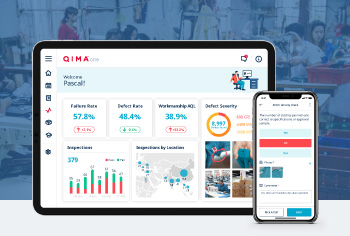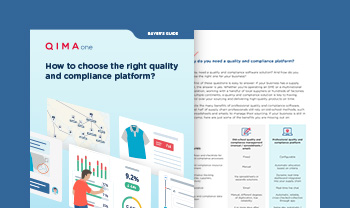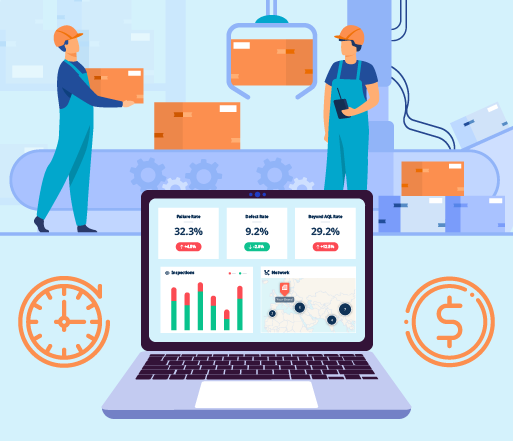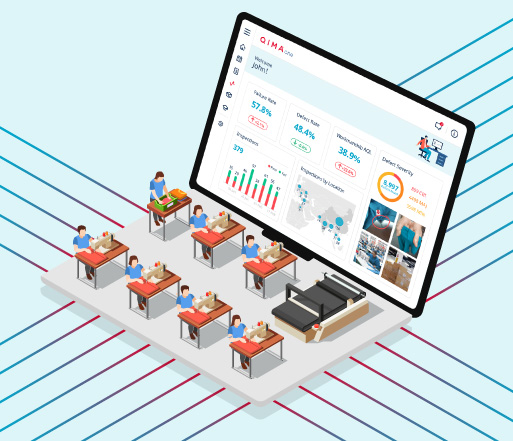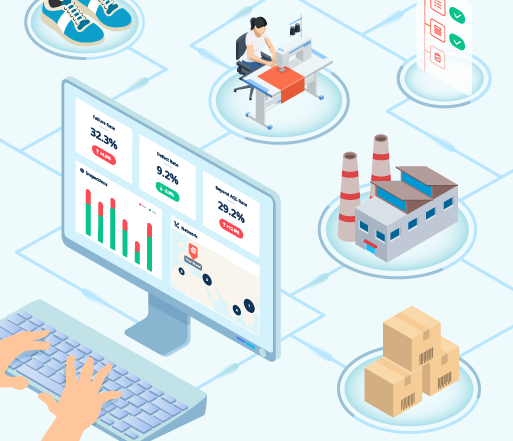
Articles
How to Perform Effective Supply Chain Data Analysis

Articles
How to Perform Effective Supply Chain Data Analysis
Articles
How to Perform Effective Supply Chain Data Analysis

Manténgase al día con la información más reciente sobre la cadena de suministro.
Getting the right information and making sure it is accurate are two key elements for attaining valuable supply chain insights. Companies that want to remain competitive need to utilize all available data to optimize their supply chain.
In this article we break down the importance of data collection and quality in supply chain management.
Key Takeaways
- Supply chain data analytics is coming to the forefront of supply chain management as a crucial tool to help improve efficiency, productivity and quality throughout each stage of the supply chain.
- The three main benefits of using data analysis within supply chain management are cost reduction, risk reduction, and improved product quality, forecasting ability and time to market.
- The best way to make the most of supply chain data analytics is to use the right tools to collect data and support analysis, such as supply chain management software. Technology allows supply chain managers to effectively take large amounts of data and turn it into actionable insights.
Background: Supply Chain Data Analytics
Data collection and quality in supply chain management are two big pieces of ‘supply chain analytics.’ Supply chain data analytics is the process of collecting and organizing data to garner supply chain insights, most often used to help supply chain professionals optimize various aspects of the procurement, processing, and distribution of goods.
While data analysis is traditionally the responsibility of a supply chain analyst, data collection and quality are playing an increasingly important role for other professionals working in and on supply chains.
Supply chain data is most often summarized in graphs and charts which provide visibility into performance and help teams adjust operations as needed.

Examples of ways supplier data can be visualized for easier interpretation.
Gaining supply chain visibility enables supply chain managers to improve the effectiveness of their operations, which over time continues to increase competition in the market. Twenty years ago, supply chain analytics technology was young and limited mostly to the large corporations that could afford to collect, manage, and interpret the large datasets associated with supply chains. Now, this technology is available to much smaller outfits and is becoming a requirement just to keep up within an industry.
The growing trend in SaaS for SCM is an indication of just how fast this technology is being adopted.

(Source) The market size of supply chain management software
The Growing Importance of Data Analytics in SCM
The adoption rate of data analytics is a clear signal to all supply chain professionals of where the industry is headed. In the last twenty years data analytics for supply chains has matured, making these services a must-have for competitive companies in nearly every sector.
A Brief History of Supply Chain Analytics
- Pre 1990s – Data shared by participants in a supply chain was stored in spreadsheets or basic databases. It was analyzed primarily to help with demand planning and forecasting. Access to these insights was limited to innovative companies with the resources to afford the technology and expertise required.
- 1990s – An expanding internet and improvements in software like ERP made it easier for data exchange between supply chain participants. Mid-sized companies gained access to these tools as they became more user friendly and affordable. The early adopters who utilized this new technology gained a considerable advantage over competitors.
- 2000s – Outsourcing and multi-tier supply chains became more ubiquitous, driving the demand for supply chain optimization tools. As the market for supply chain data collection and analysis expanded to fill demand, more options solutions arose. Small-medium sized companies previously limited by resources started gaining access to planning and analytics software.
- 2020s - The companies that weren’t early adopters are realizing the importance of supply chain analytics and are racing to catch up. The innovative companies with available resources are using the latest tech to further improve their insights. They are experimenting with unstructured data to further optimize their supply chains (more on this below). The next frontier is integrating AI and blockchain technologies for insights that can’t be seen through traditional methods.
The Current Ecosystem
It is now commonplace for companies to contract with, or have, in house supply chain analysts to collect, manage, and extract insights from their supply chain. Supply chain managers use these insights to make informed decisions about planning, streamlining operations, and risk reduction on a daily basis. The three big benefits of utilizing supply chain data are:
Cost Reduction
Supply chain managers can increase their margins by making their supply chains more efficient. Gaining insights from proper data analytics can help them make decisions about how and when to best utilize resources. An analysis of operations may allow them to see how a few small adjustments can add up to big cost savings over time.
Risk Reduction
Accurate and timely data helps catch potential quality, compliance, and supplier issues in their early stages. Supplier performance data for example, can help a supply chain manager see suppliers that are improving or declining in performance over time and recognize red flags that may lead to more serious problems down the road. Identifying and fixing these potential issues early can prevent a manageable supplier issue from developing into a supply chain crisis.
Increased Effectiveness
Along with reducing cost, a more effective supply chain can help a company be more competitive by improving quality, more accurately forecasting consumer demands, and getting products to market faster than competitors. Underlying these valuable insights is a process of collecting and organizing the right data.
Data Collection – Getting it Right
Just like getting a product to market, building a proper foundation of supply chain data requires teams to manage the quantity and quality of their data from beginning to end.
What are the main areas to collect data?
Supply chain professionals can collect and utilize data throughout each step of their supply chain, giving them the visibility, they need to make adjustments in each area. Some of the biggest data sources come from:
- Raw Materials Suppliers
- Manufacturing Audits and Inspections
- Logistics
- Inventory
- Export and Import Trends
- Retail Sales & Returns
- Market Trends
Each of these sources can provide valuable information about opportunities to streamline processes and reduce risks, but the data needs to be collected, stored, and processed in a useable format.
What type of data should be collected?
The conventional approach to data collection is harvesting as much data as possible, then finding a way to utilize it. Supply chain data falls into two categories: structured and unstructured.
Structured data is organized, quantitative information that is in or can be entered into a spreadsheet or database. This is the type of data most of us are familiar with.
Unstructured data is unorganized, qualitative information that cannot be processed or organized like structured data. This type of data usually comes from text sources like written reports or social media or can be unorganized data from a sensor like a smart tracking (IoT) tag on a retail item.
Both forms of data are valuable, but depending on your needs and data processing capabilities, may not be applicable. For companies in the early stages of collecting and analyzing supply chain data, harvesting structured data to help improve a specific area of your supply chain is the best place to start.
Learn how Ariat reduced
their poor quality costs
Learn now

Learn how Ariat reduced
their poor quality costs
Learn now
How to Start Collecting Data?
In many cases the information you need, such as the pass-fail rate on product inspections, is recorded in a digital report, spreadsheet, or possibly a notebook. For it to be of value to a supply chain manager, you need it in your software system where it can be evaluated and used to find insights such as risks of declining supplier performance.
For data that is readily available, it simply needs to be integrated into a supply chain management software that can help you standardize reporting, and organize data and build dashboards for evaluating it. Naturally this will be a key attribute to look for when evaluating SCM software solutions.
Setting up data sources is not the end of your data requirements. You also need to account for accuracy, ensuring the foundation of your analysis is trustworthy.
Data Quality – Insights from Accurate Information
Good in, good out. These three areas of data quality help in evaluating how useful your data inputs will be in providing supply chain insights.
Accurate – If the data is recorded wrong, you’re going to get misguided insights. This can be mitigated in many instances by integrating a third-party service to collect and report for you. This is especially common in supplier audits and product inspections in the factory, where having a third party reduces the chance of corruption.
Comprehensive – More of the right data is better. To get the most accurate picture of reality, collect the right data and enough of it to give you a significant signal. If you only have data on product returns from a handful of retailers, you could be misled to believe a problem in their stores is true across all retailers when in fact your sample size isn’t representative.
Real Time – After quality of data, optimize for speed. If you can make decisions quicker than your competitors, you’ll have an advantage in getting to market faster, adjusting to meet changes in supply and demand, price adjustments, and much more. The desired benchmark for innovative companies today is to be able to have “real time” data so they can make adjustments before problems arise.
Companies with the need and resources will have a dedicated team or a consulting agency help them with data analytics. Smaller companies working on improving manageable areas of their supply chain can utilize tools and part-time consultants to help them get it right.
Supply Chain Tools That Help Collect and Use Data
The growing number of software solutions entering the market gives supply chain professionals a plethora of options to help them be more effective, but can also present a decision challenge. If you are going to invest time in adopting a new supply chain tool, which tool is right for your company and how do you find it? As you take inventory of the needs you’d like a tool to meet, consider these key attributes:
- Data Governance – how is the creation, management, and usage of data standardized to ensure accuracy? Do you have in-house expertise, or will you require outside support?
- Education & Training – does the tool come with a method for helping you onboard all participants and keep everyone up to speed with latest standards?
- Usability – is it simple enough to lower the barrier of adoption so that your key stakeholders adopt it?
- Focus / Footprint – what opportunities need to be met now and in the near future? For many companies, streamlining supplier quality management may be 80% or more of their opportunity for supply chain optimization. In this case, a software dedicated to those needs might be the right fit, as opposed to a complex tool with unnecessary features.
For example, QIMAone’s quality management software offers onboarding support and configurable workflows to help supply chain managers smoothly integrate this powerful tool into existing operations. Furthermore, a reporting and analytics tool can sit on top of all other tools to bring big data together for further insights.
What’s next? The future of supply chains will undoubtedly be shaped by an increase in data and the capacity to analyze it. Smart devices and monitoring systems are generating data by the terabyte and artificial intelligence is pulling hidden patterns out of massive data sets.
The only thing we can be certain of is that the companies and professionals who best utilize these new technologies will continue to gain a competitive advantage over their peers.
Artículos más populares
Planes de Acción Correctiva 101: Su guía de referencia para garantizar excelencia en la calidad de la cadena de suministro
Las ventajas de una cadena de suministro basada en datos
6 Benefits of Supply Chain Visibility
Cómo implementar un sistema de gestión de calidad
Simpli Home: Garantizar la calidad y el cumplimiento de los productos con la tecnología de la cadena de suministro
7 formas eficaces de mejorar el sistema de gestión de calidad
Supply Chain Visibility: Complete Guide for Supply Chain Managers
Mejore su control de calidad con métricas de rendimiento del proveedor
